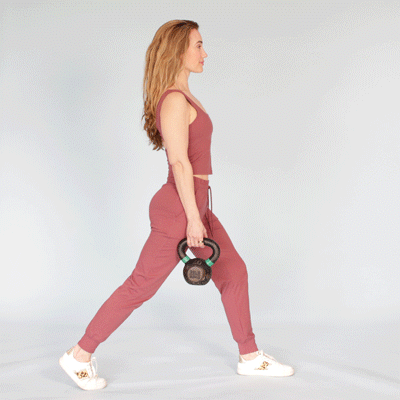Kettlebell sessions can engage multiple muscle groups simultaneously within a short timeframe. They’re effective for enhancing strength, power, and cardiovascular endurance.
Kettlebells serve as a popular option for strength training, offering an alternative to traditional barbells, dumbbells, and resistance machines.
Originally used as agricultural tools in Russia, kettlebells were later reimagined as weights for exercise after strongmen used them in displays of strength.
Kettlebells for workouts usually range in weight from 1.5–45 kilograms (kg). You can perform a full-body session using just a kettlebell, or incorporate select kettlebell moves into your existing routine.
The American Council on Exercise (ACE) offers the following kettlebell weight guidelines for adults, based on experience level:
BeginnerIntermediate to advancedMale15–25 lbs (7–11 kg)35 lbs (16 kg) or more Female8–15 lbs (4–7 kg)18 lbs (8 kg) or more
Several elements can affect which kettlebell weight is best for you, including the particular exercise and your general health status.
Continue reading to discover seven adaptable kettlebell movements to integrate into your workouts, along with the advantages and potential hazards of kettlebell training.
1. Deadlifts
Deadlifts are a compound movement, meaning they work several muscle groups together. The ACE recommends deadlifts as a solid initial exercise to kick off a kettlebell session.
- Muscles worked: glutes, quadriceps, back muscles
- Reps: 6–8
How to do kettlebell deadlifts
- Stand with your feet shoulder-width apart.
- Position a kettlebell just outside each foot on the ground.
- Brace your core and pull your shoulders down while squeezing your shoulder blades together.
- Hinge at the hips and bend your knees to reach the kettlebell handles.
- Grasp the kettlebells firmly, keeping your arms and back straight and your feet flat on the floor.
- Slowly lift your chest and thrust your hips forward until you’re standing upright.
- Pause and inhale before lowering back down.
- Repeat 6–8 times. Start with 1 set, progressing to 3–4 sets as your strength increases.

3. Kettlebell goblet squat
Goblet squats are a highly effective lower-body compound move. Adding a kettlebell increases the challenge of the squat.
- Muscles worked: quadriceps, hamstrings, calves, glutes, core muscles
- Reps: 6–8
How to do the kettlebell goblet squat
- Stand with your feet slightly wider than shoulder-width, toes pointed slightly outward.
- Grip the kettlebell with both hands around the sides of the handle (not from the top) and hold it close to your chest.
- Slowly bend both knees until your thighs are nearly parallel to the floor. Keep your elbows forward and your back straight.
- Push through your legs to return to the starting position while keeping your torso stable. Keep your feet planted.
- Repeat 6–8 times. Begin with 1 set and work up to 3–4 sets as your strength improves.

4. Kettlebell lunge
Similar to traditional lunges, kettlebell lunges engage a variety of lower-body muscles. They also serve as a useful exercise for balance.
- Muscles worked: glutes, quadriceps, hamstrings
- Reps: 6–8
You can hold the kettlebell with both hands to up the difficulty.
How to do the kettlebell lunge
- Stand with your feet together.
- Hold the kettlebell by the handle in one hand, arm resting at your side.
- Keep your shoulders back and chest upright.
- Step forward slowly with your left leg, bending the knee while keeping the right foot planted.
- Pause briefly, then press down through the front foot to return to standing.
- After completing reps on one leg, switch sides so the kettlebell is in your other hand and the right leg steps forward.
- Start with 1 set of 6–8 reps per leg, and aim for 3–4 sets as your fitness increases.

5. Russian twist
The American Sports and Fitness Association notes the Russian twist can help:
- enhance balance and stability
- improve posture
- strengthen the core
Make sure you maintain a secure hold on the kettlebell to avoid dropping it onto your lap.
- Muscles worked: core muscles, obliques
- Reps: 6–8
How to do the Russian twist
- Sit with your knees bent and feet flat on the floor.
- Hold the kettlebell handle with both hands and lean back so your torso forms about a 45-degree angle to the floor.
- Lift your heels a few inches off the floor and rotate your torso from right to left, moving the kettlebell slightly across your body.
- Rotate side to side for 6–8 reps.
- Return to your starting position after the set.
- Begin with 1 set and progress to 3–4 sets as your fitness and strength improve.

6. Kettlebell pushup
Pushups are a foundational strength exercise with many variations. Using kettlebells can challenge your balance and engage your core more intensely.
- Muscles worked: chest, shoulders, triceps, core
- Reps: 6–8
While performing kettlebell pushups, keep your wrists neutral rather than bent. If you feel unstable or your wrists can’t support you, stop to avoid injury.
How to do the kettlebell pushup
- Place two kettlebells about shoulder-width apart on the floor.
- Grab each handle and assume a pushup position. Use a modified pushup position if needed.
- Keep your core tight, back straight, and the upper body rigid as you lower toward the floor.
- When your chest aligns with the kettlebell handles, exhale and press back up to the starting position.
- Be careful not to arch your back during the movement.
- Perform 6–8 reps. Start with 1 set and work toward 3–4 sets as you get stronger.

7. Kettlebell shoulder press
A study found that performing shoulder presses with kettlebells rather than dumbbells elicited greater activation in the targeted muscles.
- Muscles worked: shoulders, triceps
- Reps: 6–8
Choose a weight you can handle safely for this exercise.
How to do the kettlebell shoulder press
- Stand with your feet about shoulder-width apart.
- Hold a kettlebell by the handle in your right hand so it rests near the outside of your right shoulder. Your palm should face toward your chin and your elbow kept close to your side.
- Exhale as you press the kettlebell upward until your arm is nearly extended overhead.
- Slowly lower the kettlebell back to the starting position, keeping your wrist and forearm neutral and elbow close to your body.
- Complete 6–8 reps with one arm, then switch sides. Start with 1 set per arm and progress to 3–4 sets as you advance.

Benefits of using kettlebells
Research indicates kettlebell training may offer several advantages, including:
- improvements in strength, aerobic capacity, and cardiovascular fitness
- better glucose tolerance, which could help reduce diabetes risk
- enhanced posture and stability
- increased muscle mass and improved grip strength in older adults
- reduced inflammation in older adults
- cost savings
Risks of using kettlebells
Kettlebell training can complement your fitness routine, but it carries some risks. A 2017 study cites potential injuries such as:
- bruised forearms
- tendon strains in the wrists and hands
- lower back injuries
Dropping a kettlebell can also injure your foot or any body part in its path.
Kettlebell safety tips
You can lower your injury risk and get more out of your training by following these guidelines:
- if you’re new to kettlebells, begin gradually
- use lighter weights initially to learn proper technique
- wear stable, closed-toe shoes when handling kettlebells
- maintain a steady grip and become accustomed to the swinging motion of the weight
- prioritize good posture, form, and alignment to avoid injury
- remember to breathe throughout each repetition
- stop at once if you experience a sudden, sharp pain
A certified personal trainer at a gym or fitness center can demonstrate correct kettlebell form and advise on safety gear such as lifting gloves and wrist supports.
If you’re making a significant change to your activity level, it’s wise to consult your doctor first.
Frequently asked questions
Do kettlebell workouts really work?
Yes—research shows they’re comparable to other resistance tools for building power, endurance, and strength.
Can you get in shape with just kettlebells?
Yes. A variety of kettlebell exercises can help boost both aerobic and cardiovascular fitness.
What kind of body do kettlebells give you?
Kettlebell training can engage the entire body’s musculature, helping to develop strength, power, and cardiovascular conditioning.
Is 30 minutes of kettlebells enough?
Studies suggest kettlebell circuit workouts of that duration can improve muscular, cardiovascular, and overall fitness.
Takeaway
Kettlebells can take some getting used to, but with correct technique they offer gains in both strength and cardio capacity.
One kettlebell can work multiple muscle groups at once, making it a versatile option for total-body training.
If you’re uncertain about how to begin, consult a certified personal trainer or physical therapist. They can design a tailored program that aligns with your goals while reducing the risk of injury.


















Leave a Reply
You must be logged in to post a comment.